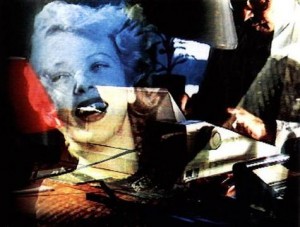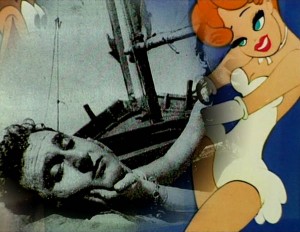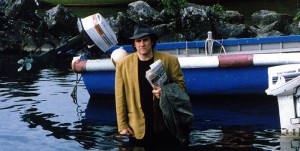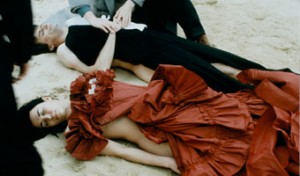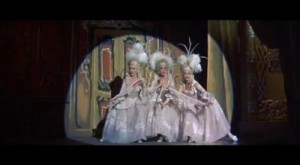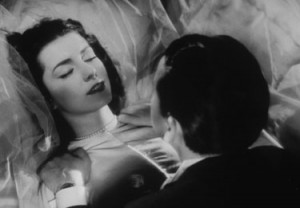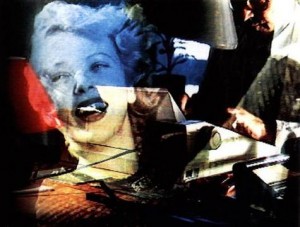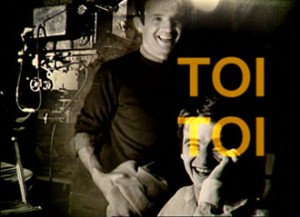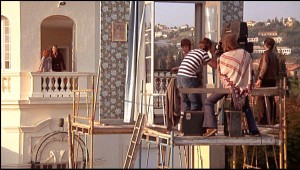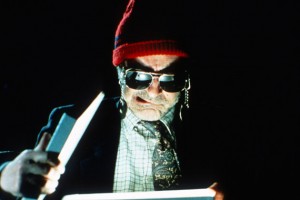From Film Comment (September-October 1998). This is a restructured and substantially revised, updated, and otherwise altered version of my “Trailer for Histoire(s) du cinéma,” which appeared originally in French in the Spring 1997 issue of Trafic. Among the more important changes are a suppression of virtually all of my multiple comparisons of Histoire(s) du cinéma with Finnegans Wake in the original (which, paradoxically, seemed more appropriate in a French publication than in an American one), an expansion of much of the interview material, and an extended quotation from Godard’s review of Rob Tregenza’s Talking to Strangers.
My apologies for some format irregularities that I wasn’t able to fix. -– J.R.
Part of the following derives from two film festival encounters — a panel discussion on Godard’s Histoire(s) du cinéma held in Locarno in August 1995, and some time spent with Godard in Toronto in September 1996. I participated in the first event after having seen the first four chapters of Godard’s eight-part video series; unlike my co-panelists, I’d been unable to accept Godard’s invitation to view chapters 3a and 3b, devoted to Italian neorealism and the New Wave, in Rolle a few days earlier. A little over a year later, Godard brought these chapters and a still more recent one — 4a, on Hitchcock — with him to Toronto, where he was presenting For Ever Mozart and Rob Tregenza’s Talking to Strangers (the latter in Toronto’s “Talking with Pictures” series), and showed me these three videos in his hotel room over two consecutive evenings. We also had some opportunities to talk; some of our conversation was recorded, along with Godard’s press conference, but much of it wasn’t.
Then, in mid-December, for an article I was writing about Histoire(s) du cinéma for the French quarterly Trafic (portions of which are recycled below), Godard generously assisted me by sending me copies of all the completed chapters to date. More recently, he completed the final chapter, then went back and made revisions on all eight parts before declaring the work finished.
I should admit here to a bias that I was reluctant to express quite as directly to Godard, given his friendliness: Nouvelle Vague and Histoire(s) du cinéma strike me as being two of his greatest works, Hélas pour moi and (to a much greater extent) For Ever Mozart two of his weakest, at least since his embattled “Dziga Vertov Group” period (roughly 1968-72). This isn’t to say that all of Godard’s work isn’t interesting and important on some level, only that the gains and losses that come from his increasing solitude deserve to be examined rather than merely patronized. (Part of what I found most affecting about this solitude in Toronto was Godard’s clear desire to communicate, which clearly went beyond his usual desire to provoke.)
At least since Passion (82), Godard’s work has been obsessively concerned with beauty in a way that few of his Sixties films were, even the most beautiful. My preference for Histoire(s) du cinéma, Hélas pour moi, Nouvelle Vague, Germany Year 90 Nine Zero, and 2 x 50 Years of French Cinema over Les Enfants jouent à la Russie, JLG/JLG, and For Ever Mozart has a lot to do with how much this impulse connects with something beyond self and hermetic metaphors –- namely the history of both cinema and the 20th century, the life of privilege, the collapse of Communism, and the history of French cinema. It’s a matter of engagement versus disengagement — the same thing that makes me prefer the politics of the Seventies works Godard made with Anne-Marie Miéville to those of the films made just before with Jean-Pierre Gorin, which smack of attitude and academic posturing (or is it “positioning”?).
“War — the theater of operations — follows theater,” he writes it the For Ever Mozart pressbook. “And cinema follows war. In both instances, actors are gotten cheap and will have to pay for it.” Again and again in the film, theater is viewed as war and war is viewed as bad theater — both put together by open casting calls and brutal auditions: a Musset play that’s never performed when Camille’s theater company gets wiped out en route to Sarajevo, a film called Fatal Bolero that’s shot by her father but then gets shown in empty theaters. Amy Taubin wrote last July, “I have no doubt … that it’s the most straightforward and profound of the films Godard has made about war, beginning with Les Carabiniers,” but I beg to differ. Les Carabiniers (1963) is scruffier and funnier and goes much deeper because it’s more in touch with the world in front of the camera: muddy wasteland, grubby and anonymous actors, even the war films it mocks and periodically emulates; consequently it’s more in touch with the audience. For Ever Mozart, featuring another cast of unknowns, prefers to stage its own metaphors in glossier terms — classical music, compulsively well-lit images of bad actors barking quotations at one another. Shooting the decorously arranged lower half of a female corpse lying in a doorway, Godard can’t resist asking us to admire the shape of her ass.
***
In the following, all quotations from my conversations with Godard in Toronto are indicated by the abbreviations JR and JLG; those from his press conference in Toronto — some of which I’ve stitched together from separate answers, hopefully without misrepresenting him – are labeled Q (for question) and JLG; all these quotations are italicized.
GODARD AS HISTORIAN
JR: Whenever you recount a history there’s an implication that something is over, and it seems that one implication of Histoire(s) du cinéma is that the cinema is over.
JLG: The cinema we knew. We also say that of painting.
In Godard’s first phase as a filmmaker (roughly 1959-68), he functions very much as a historian of the present, literally as well as figuratively — a major dimension of his work that becomes diminished once he forsakes Paris for Grenoble and then rural Switzerland. Arguably, it is only when Switzerland functions as Switzerland in his films of the Nineties, as in Nouvelle Vague — or when Germany functions as Germany in Germany Year 90 Nine Zero — that the Godardian sense of both place and period survives intact. In Hélas pour moi and, even more, For Ever Mozart, by contrast, there is a sense of relative “placelessness” that also seems to locate both films outside of time, in spite of their many topical references. Interestingly enough, this ceases to be a problem in most of his videos; in Histoire(s), the only ongoing “place” that counts is cinema, not Switzerland, and perhaps for this reason, it has recently been in video, not film, that he functions most comfortably as a historian. [JLG:…For Ever Mozart is shot on the property belonging to my grandfather when I was young, and, it’s so destroyed today, it fits very well for Yugoslavia.]
Q (JR at press conference): Why is For Ever Mozart three words instead of two?
JLG: “Forever” in America is one word? Because it’s a French movie. (Laughter.) In France, there is a joke [i.e., pun]: “Il faut rêver” -– one must dream. Q (Al Milgram at press conference): Why was there no criticism of the Bosnian war at all in the film like you had in the Vietnam-era films with the U.S. in Vietnam?
JLG: Because the movie has nothing to do with the Bosnian war. The title [of the play Camille speaks about] isn’t Sarajevo or The Tragedy of Sarajevo, it’s One Shouldn’t Play With Love in Sarajevo. In Europe, intellectuals are so guilty for having done nothing, they always ask me about Sarajevo. No one there or in New York or in Toronto asks me about One Shouldn’t Play With Love.
Q: Why did she want to produce the play?
JLG: Because she was Camus’ granddaughter. It’s reason enough. It’s an image, and it corresponds in my opinion to the Camille of Musset, a character who is a very soft, crazy girl, very proud, of herself, but in the inside feeling she wants to do something for herself – not for the Bosnians. She doesn’t even know where it is, Sarajevo.
Q: Do you feel that the U.S. government and other governments have used images of suffering in Bosnia for their own selfish reasons?
JLG: Yes, of course. These are not innocent people; TV networks are not charity. It’s funny, their idea of storytelling. They say that happiness is no story. In Hollywood, when there’s a story they always want to finish with happiness, a happy end, but they can get there only through catastrophe. They think that if you show happiness, people get bored. Not me. It’s a huge contradiction. It’s like in painting — movies too. I can look at only a flower for ten hours if it’s well shot. So I think the aim of the use of terrible pictures is, the more you see them, the more you don’t even look at them, unless it’s a picture of your own mother…. The image of a movie when we began was in order to remember, TV is done to forget, and, that’s what we are doing. We forget in two seconds. At the same time we’re looking, we forget. We say it’s terrible, and at the same time we forget. This is the way we want it, because if not, it would be like me, we wouldn’t look at TV. It’s like the way I can’t stop smoking. Some people can’t quit looking at TV.
JR: Why don’t you live in the city now?
JLG: Too noisy, too dirty, no water, no lake…terrible. When we were in the New Wave, we were glad to shoot in the streets, because it was the first time. At that time it was forbidden, but today it’s no longer interesting.
JR: But there’s a contradiction: your films are all set in the country now, but their culture is city culture.
JLG: To shoot on the Champs-Elysées or on 5th Avenue was something new, it was a new kind of shot. That doesn’t mean that if a young moviemaker shoots with a girl and boy on Champs-Elysées now that it might not be interesting. But it’s not new. For us it was a kind, of freedom recovered. We had to do that, because it was simply forbidden. It was an escape, just as it was an escape for Cassavetes to go where he did when he shot Husbands. And what I like about the way that Rob Tregenza goes into the street [in Talking to Strangers] is that it’s new again, there is a necessity to go into the streets that way. It’s not done in other young pictures.
Godard’s historical impulse can already be seen in a mocking juxtaposition of shots reportedly eliminated by the French censors from A bout de souffle -– a cut from Charles de Gaulle in a car following Dwight D. Eisenhower in a car in a procession down the Champs-Elysées to Jean-Paul Belmondo following Jean Seberg down the sidewalk. This conflation of the sexual with the military/political rhymes with the rude simile proposed in chapter 1a in Histoire(s) du cinéma over a frenzied montage synthesizing a musical number (“Ladies in Waiting”) from Les Girls, Max Ophüls, Molière, Madeleine Ozeray, Louis Jouvet, and even Bogart: “1940, Geneva, L’École des femmes, Max Ophüls. He falls upon Madeleine Ozeray’s ass just as the German army takes the French army from behind.” The reference is to Ophüls’ unfinished filming of a stage performance of the Molière play, and the significance here is again the simultaneity of what’s happening in cinema and what’s happening in the world outside — a point made equally in the same chapter when Godard rhymes a figure in a skeleton costume at the masked ball in The Rules of the Game (1939) with concentration camp victims, or when, in 3a, he links Elina Labourdette’s penultimate line in Les Dames du Bois de Boulogne (1945),”l struggle,” to de Gaulle saying to the free French, “We must struggle,” around the same time.
This latter linkage has prompted Godard to call Les Dames du Bois de Boulogne the “only” film of the French Resistance, and even if one chooses to reject such a notion, it becomes possible to appropriate it as a critical insight into the early films of Robert Bresson. For it might be argued that some of Bresson’s most important identifying traits as a filmmaker — such as his uses of off-screen sounds to replace images, or the sense found in all his films of souls in hiding, of buried identities and emotions –- might be traceable in part to his nine months (1940-41) in a German internment camp and his subsequent experience of the German occupation of France. This applies not only to his masterpiece about the French Resistance, A Man Escaped (1956) — where the sounds of the world outside Fontaine’s prison cell create as well as embody his very notion of freedom — but also to his other early features. Such an interpretation can of course be debated, but it seems to me a far more fruitful approach to Bresson’s style to see it growing out of concrete and material historical experience than to treat it as a timeless, transcendent, and ultimately mysterious expression of abstract spirituality. (Judging from Michel Ciment’s recently published interview with Bresson in Positif no. 430, Decembre 1996, Bresson may share this bias himself: “To treat me like a Jansenist is insane: I’m the opposite of a Jansenist, I search for an overall impression. When I’m on the grand boulevards, I ask myself straightaway, ‘What sort of impression do they make on me?’ And in fact this impression is of a jumble of legs which makes a sharp sound on the pavement. I’ve tried to render this impression with sound and image.”) And Godard’s historical linkage, without actually propounding this critical argument, at least points us in the proper direction. It’s a way of saying that cinema is concerned with the world, not with an alternative to it, and that cinema belongs to the world, including us.
In terms of the overall myth of Histoire(s) du cinéma, the cinema and the 20th century — almost interchangeable in Godard’s terms — are contextualized by two key countries (France and the United States), two emblematic studio chiefs (Irving Thalberg, Howard Hughes), and two emblematic world leaders (Lenin, Hitler); two decisive falls from cinematic innocence (the end of silent film that came with the talkies and the end of talkies that came with video); two decisive falls from worldly innocence (World War I and World War II); and two collective cinematic resurgences that took place in Europe, affecting the moral and aesthetic of the rest of the world (Italian neorealism and the New Wave).
JR: There’s a sequence from Que Viva Mexico in chapter 2a that seems edited in a very Eisensteinian way. Is this editing yours?
JLG: No, it’s Marie Seton’s. In a sense, I think I’m virtually unassailable in Histoire(s) du Cinéma. I used Marie Seton’s because it was the very first one that we knew about, Time in the Sun. Jay Leyda had not yet done his critical work on it, and I never saw that version; it was the kind of movie we never saw. And so, since I was speaking of the New Wave, it has to be Marie Seton. Because Marie Seton belongs to the same epoch as Jean-Georges Auriol, who was so fond of Marie. If it was another episode, maybe I would have edited the footage myself. I’m not ashamed to re-edit another filmmaker.
Everything came from the New Wave. First it was spreading and then it disappeared. That’s why I said to Anne-Marie [Miéville], “At the time of Jean Vigo, it was the same as it is for us now: ‘difficult,’ a flop, no one’s seeing it.” But because of what happened at the time of neorealism and then at the time of the New Wave — because of the theory of all that — attendance went up. And now it’s going down again. It’s always been like that. I say what I mean in the third episode of Histoire(s) du cinéma: it’s evident that movies are capable of thinking in a better way than writing and philosophy, but this was very quickly forgotten. So this is what happened. The New Wave was a miracle. It was a crystallization of what James Agee wrote about.
Q (at the press conference): Did you and Truffaut have the same views on filmmaking?
JLG: In the end, no, totally different. But we were younger, we were French, we were fighting, we had no money and we tried to survive, full of hope and faith. And as soon as we began to do pictures, the pictures showed we had different tastes, and then we began to disagree. I thought – and I still think – that François was not a good director. He was a great critic, a great agitator and polemicist…the successor of Diderot, Malraux, Bazin – better than [Serge] Daney. To be a successor of Diderot is to be much better than I am; I’m not even a successor of Malraux. But he was more commercial, and there was a difference between him and me. I came from a very rich family, he came from a very poor family, with divorced parents. To have a success was very important for him and I didn’t need that. My first movie [Breathless] was a success, but I never thought it could be; then I made a second one [Le petit soldat] that was first censored and then, three years later, it had no success – and that protected me from success. Because success is corrupting; it’s very difficult to avoid that.
For me, the way to succeed was to be unsuccessful, bit to make a living on that. François was the exact contrary. But he was representing us [the New Wave], and because of his success, especially in America, he was in a sense protecting us. Since Day for Night was a success, it protected me in a way to make a picture like King Lear, which was considered a disaster even by my American friends. We couldn’t be attacked because of François. He was like a battering ram.
***
How much of a historian is Godard? A complex question, almost as complex in a way as asking the same question about James Joyce in Finnegans Wake. “That which has never taken place is the work of the historian,” reads an early title in chapter 2a. Much of Godard’s work since the 80s is concerned with amnesia — a subject that becomes especially important in his King Lear (1987) and 2 x 50 ans de cinéma français — but there are times when Godard’s own amnesia seems as much of an issue as everyone else’s.
Case in point: The epigraph of Contempt, attributed to André Bazin and appearing also in the beginning of episode 1a and in For Ever Mozart, is, “Cinema substitutes for our gaze a world that corresponds to our desires.” But to all appearances, neither the quotation nor the attribution is correct. A more probable source is a sentence that appears in “Sur un art ignoré” by Michel Mourlet (Cahiers du cinéma no. 98, août 1959, nine months after Bazin’s death): “Since cinema is a gaze which is substituted for our own in order to give us a world that corresponds to our desires, it settles on faces, on radiant or bruised but always beautiful bodies, on this glory or this devastation which testifies to the same primordial nobility, on this chosen race that we recognize as our own, the ultimate projection of life towards God.”
Another example: in excerpts from a document (published in English in Jean-Luc Godard: Son + Image, edited by Raymond Bellour with Mary Lea Bandy, New York: The Museum of Modern Art, 1992, 132) written and assembled by Godard alongside Histoire(s) du cinéma — an early version of a book scheduled to be published by Gallimard at the same time that the complete video series premiered in Cannes — Godard incorrectly describes Howard Hughes as the “producer of Citizen Kane”.
False quotations and false attributions are, of course, quite common in film criticism. Although Godard himself is correctly credited for having made the famous remark, “Tracking shots are a matter of morality,” what is almost invariably omitted from this attribution is that Godard was merely inverting a sentence by Luc Moullet published four months earlier: “Morality is a matter of tracking shots.” Godard’s version of the epigram is perhaps the more memorable of the two, and it’s theoretically possible that Moullet was only paraphrasing something he heard Godard say at an earlier date. For that matter, Mourlet may (or may not) have been paraphrasing something he might have read or heard from Bazin. The point, in any case, is I don’t know, and the history of film and film criticism abounds with such cases of not knowing. A surfeit of not knowing, however, produces only confusion, and the advantage of false or at least dubious quotation and attribution in this case is that they produce some form of history — or, more precisely, histoire(s)….Is it true, as Godard asserts in 2b, that F.W. Murnau and Karl Freund invented Nuremberg lighting while Hitler still couldn’t afford a beer in a Munich café? Whether true or not, it is certainly a form of history, poetry, and criticism, transforming the object of our gaze.
(to be continued)

